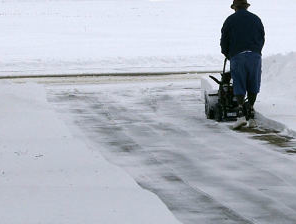
01 Dec Rock Salt vs. Calcium Chloride — Which is Best?
 As snow and ice become more commonplace at this time of year, homeowners frequently ask for advice on what steps they should take to minimize the risks of slips and falls on sidewalks and driveways. Shoveling and plowing remove the majority of snow from these surfaces, but a thin and dangerous layer of ice often remains.
As snow and ice become more commonplace at this time of year, homeowners frequently ask for advice on what steps they should take to minimize the risks of slips and falls on sidewalks and driveways. Shoveling and plowing remove the majority of snow from these surfaces, but a thin and dangerous layer of ice often remains.
The two deicers often used to treat these icy conditions are rock salt (sodium chloride) and calcium chloride, but which is best? The experts at Grasso Development have plenty of experience dealing with winter conditions, and are very familiar with both products.
“We recommend calcium chloride for several reasons,” said Grasso Development President Jeffrey Grasso. “Although it is more expensive, calcium chloride offers several advantages over rock salt. One of the most obvious advantages is that it can be effective at much colder temperatures than rock salt.”
In fact, calcium chloride can be effective at temperatures as low as -25 degrees Fahrenheit, while rock salt loses its effectiveness at temperatures below 15 degrees Fahrenheit.
Many homeowners purchase rock salt because it is less expensive than calcium chloride, but even when temperatures are above 15 degrees Fahrenheit there are some disadvantages. Rock salt poisons soil, is damaging to trees and other vegetation, and can damage concrete. It can also be harmful to pets, particularly if sharp pieces become lodged in paws. Pets then lick their the irritated paws and can ingest the salt.
Calcium chloride poses less risk to plants and does not possess the sharp edges found on rock salt. It also attracts water, and creates heat as it reacts with water and melts snow and ice on contact.
The optimal way to deal with snow and ice is to remove as much of it as possible using plow, snowblower or shovel first, and then use only as much calcium chloride or rock salt as is needed to do the job. The deicers should not be simply dumped on top of large amounts of snow or ice.
Grasso Development takes pride in its the knowledge and experience it has acquired in the area of building and maintaining fine homes for three generations and more than fifty years. If you have questions about custom home building, renovations or home maintenance in the Westchester, NY area, call Grasso Development at (914) 632-0525.